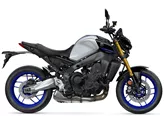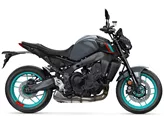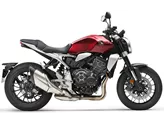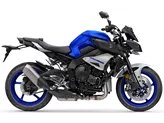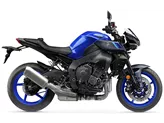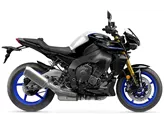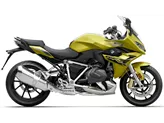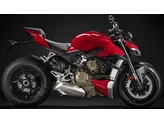Yamaha MT-09 2016 vs. Yamaha MT-10 2016

Yamaha MT-09 2016

Yamaha MT-10 2016
Vue d’ensemble - Yamaha MT-09 2016 vs Yamaha MT-10 2016
The Yamaha MT-09 and MT-10, both released in 2016, are naked bikes that offer impressive performance and a thrilling riding experience. While they share some similarities in terms of engine type, front suspension, and front tire dimensions, there are notable differences between the two models.
Starting with the Yamaha MT-09, it is equipped with a 115 HP inline three-cylinder engine that delivers a torque of 87.5 Nm. With a displacement of 847ccm and three cylinders, this bike offers a powerful and responsive performance. The front suspension is a telescopic fork, providing stability and control on various road surfaces. The frame is made of aluminum and has a twin tube design, ensuring a lightweight and rigid structure. The front brakes are double disk, offering reliable stopping power. The front and rear tire widths are 120mm and 180mm respectively, with a diameter of 17 inches. The wheelbase is 1440mm and the seat height is 815mm. With a curb weight of 191kg (with ABS) and a fuel tank capacity of 14 liters, the MT-09 strikes a balance between agility and practicality.

Yamaha MT-09 2016
On the other hand, the Yamaha MT-10 boasts a more powerful inline four-cylinder engine, generating 160 HP and 111 Nm of torque. With a displacement of 998ccm and four cylinders, this bike delivers exhilarating acceleration and top-end performance. The front suspension is an upside-down telescopic fork, providing enhanced stability and precise handling. The frame is also made of aluminum but has a deltabox design, offering a combination of strength and flexibility. The front brakes are double disk, ensuring strong and consistent braking performance. The front and rear tire widths are the same as the MT-09, but the rear tire diameter is slightly larger at 190mm. The wheelbase is 1400mm and the seat height is 825mm. With a curb weight of 210kg (with ABS) and a fuel tank capacity of 17 liters, the MT-10 is slightly heavier and has a larger fuel capacity, making it more suitable for longer rides.
In terms of strengths, the MT-09 impresses with its wonderfully powerful three-cylinder engine, offering three power modes for versatility. The fully adjustable chassis and standard quickshifter enhance the bike's agility and responsiveness. The sporty upright seating position and good brakes contribute to a comfortable and enjoyable riding experience. Additionally, the aggressive looks and traction control system add to the appeal of the MT-09.
On the other hand, the MT-10 stands out with its CP4 engine, which provides a strong character and exhilarating performance. The bike is extremely agile and offers high-speed stability, making it suitable for both city riding and open roads. The strong brakes and unmistakable sound further enhance the overall experience.

Yamaha MT-10 2016
However, both bikes have their weaknesses. The MT-09's saddle may be a little too hard for long tours, and the license plate holder on the swingarm offers less splash protection compared to a conventional one. As for the MT-10, it may lack comfort and wind protection, and the fit may feel hard for some riders.
In conclusion, the Yamaha MT-09 and MT-10, both released in 2016, offer impressive performance and a thrilling riding experience. While the MT-09 excels with its powerful three-cylinder engine and adjustable chassis, the MT-10 stands out with its strong four-cylinder engine and agile handling. Ultimately, the choice between the two models depends on the rider's preferences and intended use, whether it be for shorter, sportier rides or longer, more comfortable journeys.
Caractéristiques techniques Yamaha MT-09 2016 par rapport à Yamaha MT-10 2016
Avantages et inconvénients en comparaison
Avantages et inconvénients en comparaison
Yamaha MT-09 2016

La Yamaha MT-09 n'a pas eu besoin d'être réinventée pour la saison à venir - elle l'a déjà été extrêmement bien il y a à peine quatre ans. Au lieu de cela, les Japonais ont misé sur un réglage fin et l'ajout de gadgets pratiques, adaptés à l'époque, comme le contrôle de traction et le changement de vitesse automatique. La norme Euro4 a une fois de plus modifié la gestion du moteur qui, en mode standard, offre un développement de la puissance certes puissant, mais bien contrôlable. Le plus grand changement, reconnaissable au premier coup d'œil, est le design, à mon avis très réussi, avec l'avant plus agressif et l'arrière redessiné. Dans l'ensemble, il s'agit donc d'une naked bike encore plus élégante, qui a clairement été construite pour le plaisir de conduire une moto.
Yamaha MT-10 2016

La MT-10, courte et trapue, est la plus éloignée de la superbike R1, tant au niveau de l'esthétique que du châssis, mais le cœur de la MT-10 est directement issu de l'arme de la piste de course et fascine par sa sonorité brute unique et sa force d'attaque par le bas grâce au décalage typique des tourillons qui, avec une séquence d'allumage modifiée, lui confère ce caractère unique. Les 160 ch qui en résultent ne semblent donc que sur le papier un peu faibles par rapport aux plus de 200 ch de la R1, mais en réalité, la MT-10 déclenche elle aussi un feu d'artifice incroyable. Le châssis serait probablement trop souple pour la piste de course, mais il est tout à fait adapté à un combat sur route et le freinage fait de même - acceptable pour la piste, mais parfait pour la route.
Comparaison des prix Prix moyen du marché Yamaha MT-09 vs Yamaha MT-10
There are a few key differences between a Yamaha MT-09 2016 and a Yamaha MT-10 2016. In terms of price, the actual average price of a Yamaha MT-10 2016 is about 34% higher. A Yamaha MT-09 2016 experiences a loss of 420 USD in one year and 720 USD in two years of ownership. This is offset by a loss of 800 USD and 1,840 USD for a Yamaha MT-10 2016. Compared to Yamaha MT-10 2016 there are more Yamaha MT-09 2016 bikes available on the 1000PS.de Marketplace, specifically 11 compared to 7. It takes less time to sell a Yamaha MT-09 with 87 days compared to 97 days for a Yamaha MT-10. Since model year 2013 1000PS.de editors have written 57 reviews for the Yamaha MT-09 and 32 reviews for the Yamaha MT-10 since model year 2016. The first review for the Yamaha MT-09 was published on 6/10/2013 and now has more than 39,900 views. This compares to more than 20,700 views for the first review on Yamaha MT-10 published on 11/17/2015.


